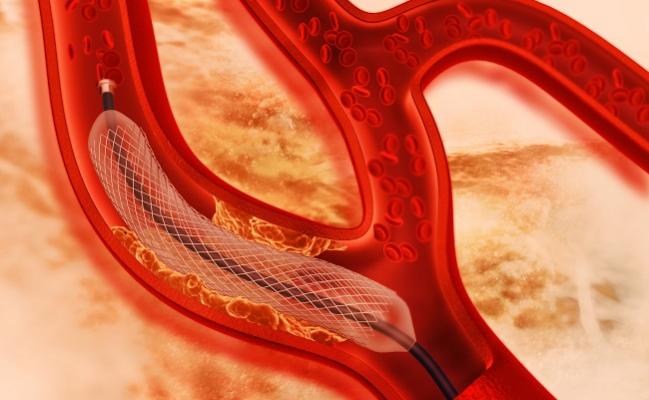New-Generation DES Better Than Older Stents Over 10 Years, Regardless of Polymer Type
Of note, a sirolimus-eluting stent with biodegradable polymer did not provide better outcomes compared with durable-polymer Xience.

CHICAGO, IL—New-generation DES provide better clinical outcomes than earlier devices over 10 years of follow-up, results from the ISAR-TEST 4 trial confirm, but a potential late added benefit of using a biodegradable versus durable polymer was not borne out.
Two new-generation stents—the everolimus-eluting Xience (Abbott) and sirolimus-eluting Yukon Choice PC (Translumina Therapeutics)—reduced rates of MACE and all-cause death compared with the first-generation sirolimus-eluting Cypher (Cordis) during extended follow-up, Sebastian Kufner, MD (Deutsches Herzzentrum München, Germany), reported here at the American Heart Association 2018 Scientific Sessions.
“The favorable outcome after new-generation DES is driven by increasing event rates over time in patients treated with early-generation DES,” Kufner said during his presentation.
There were, however, no differences in outcomes between the durable-polymer Xience and biodegradable-polymer Yukon Choice PC. It was thought, Kufner noted, that late outcomes would be better with biodegradable-polymer DES after the polymer disappears.
Serving as a discussant for the trial, Sripal Bangalore, MD (New York University School of Medicine, New York, NY), said the lack of difference between Xience and Yukon Choice PC is consistent with prior meta-analyses with medium-term follow-up.
“The late clinical benefit of biodegradable-polymer drug-eluting stents versus current second-generation durable-polymer DES remains elusive,” he said, “and this leads to a question: is a higher price tag, at least in certain healthcare systems, for some of the biodegradable stents justifiable?”
Stents Have Gotten Better
Kufner noted that long-term data beyond 5 years comparing new-generation DES with older stents and durable-polymer with biodegradable-polymer DES are lacking. The current findings, which were published simultaneously online in Circulation, help fill that gap in knowledge.
ISAR-TEST 4 was initiated in 2007 at two centers in Munich. The trial enrolled 2,603 patients with ischemic symptoms or evidence of myocardial ischemia in the presence of at least 50% stenosis in a native coronary artery, who were randomized 2:1:1 to stenting with the Yukon Choice PC, Xience, or Cypher. The mean age at baseline was 67, and about two-thirds of the patients were men. About 29% of patients had diabetes, and multivessel disease was found in about 86%; roughly 40% of patients presented with ACS.
Ten-year follow-up was available in 83% of patients, with a median follow-up of 10.6 years. Among the rest of the patients, median follow-up was 5.9 years.
At extended follow-up, there were significant differences in both MACE (all-cause death, MI, or TLR) and all-cause death across groups, driven by lower rates with the two new-generation stents.
The MACE rate was 47.7% with Yukon Choice PC, 46.0% with Xience, and 54.9% with Cypher, demonstrating relative risk reductions of 18% to 21% with the newer devices. For mortality, rates across the three groups were 31.8%, 30.3%, and 37.2%, indicating relative risk reductions of 18% to 22% with the new-generation DES.
Although there were numerically lower rates of TLR with Yukon Choice PC and Xience versus Cypher, differences across groups were not significant (P = 0.15).
Definite/probable stent thrombosis rates were low overall and did not significantly differ across groups (P = 0.09). However, risk was significantly lower with Yukon Choice PC than with Cypher (1.8% vs 3.7%; HR 0.50; 95% CI 0.27-0.93). The rate was 2.5% with Xience.
Still Work to Be Done
Bangalore, who also wrote an editorial in Circulation, briefly detailed the history of DES in his comments following Kufner’s presentation, noting that first-generation devices had problems with stent thrombosis beyond 1 year, late stent malapposition, and late catch-up of restenosis.
Polymer-related issues with the early stents were addressed in three ways: improving the biocompatibility of the durable polymer, making the polymer biodegradable, and creating DES in which the drug is eluted without the need for polymer.
The 10-year ISAR-TEST 4 data and prior studies show that those efforts to improve DES technology were successful, Bangalore indicated.
“Improvement in stent design can have [a] meaningful impact on hard outcomes, including death, and this has implications for interpretation of trials that used older-generation stents or bare-metal stents,” he said, referring to trials comparing PCI and CABG like COURAGE, BARI-2D, and FREEDOM.
But even current-generation DES have lingering issues that require improvement, Bangalore said, pointing out that the ISAR-TEST 4 results show that after 1 year, the MACE rate accrued at 3.3% per year with the new-generation devices. “We need to make continued progress in stent or scaffold technology,” he said, adding that perhaps a focus beyond the polymer is warranted.
Todd Neale is the Associate News Editor for TCTMD and a Senior Medical Journalist. He got his start in journalism at …
Read Full BioSources
Kufner S, Joner M, Thannheimer A, et al. Ten-year clinical outcomes from a trial of three limus-eluting stents with different polymer coatings in patients with coronary artery disease: results from the ISAR-TEST 4 randomized trial. Circulation. 2018;Epub ahead of print.
Bangalore S. The elusive late benefit of biodegradable polymer drug eluting stents. Circulation. 2018;Epub ahead of print.
Disclosures
- Kufner reports no relevant conflicts of interest.
- Bangalore reports serving on advisory boards for Abbott Vascular, Biotronik, Amgen, and Pfizer; receiving research grants from Abbott Vascular and the National Heart, Lung, and Blood Institute; and receiving honoraria from Abbott Vascular, Pfizer, AstraZeneca, and Biotronik.


Boris Behnisch